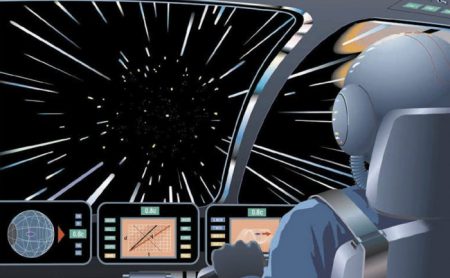March 13, 2018 – Since 2000 we have known that light itself doesn’t maintain a constant speed in a vacuum. Experiments back then, at Princeton’s NEC Laboratory, used lasers to produce faster-than-light-speed pulses by passing a beam through a specially constructed chamber containing cesium gas. A 3-microsecond pulse of light which normally would take 0.2 nanoseconds to make it from one end of the chamber to the other, emerged 62 nanoseconds earlier than if it had passed through a vacuum. The phenomenon observed was called anomalous dispersion and attributed to the effect of the cesium gas within the chamber. And what it showed is that light can move faster than the supposed speed limit of approximately 300,000 kilometers (186,000 miles) per second.
At the time of the release of the Princeton Lab findings, the head researcher for the experiment, Dr. Liujun Wang, stated that “Our experiment shows that the generally held misconception that nothing can move faster than the speed of light, is wrong. Einstein’s Theory of Relativity still stands, however, because it is still correct to say that information cannot be transmitted faster than the vacuum speed of light.”
But hold on. Enter quantum physics. In experimental results published on February 8, 2018, in the Journal of Physical Review Letters, in an article entitled, “Two-Way Communication with a Single Quantum Particle,” two quantum physicists, Jinyang Liang and Lihong V. Wang, from the Unversity of Vienna, demonstrate that quantum systems can surpass the speed limit of light.
Their experiment involves the exchange of a single quantum particle (a photon) by two individuals at the same time with both in receipt of the results in half the normal time of a transmission traveling at the speed of light.
Why is it even possible to exceed the speed of light by double? Because of quantum superposition. That is the single photon each participant in the experiment sends gets canceled or transposed at the same time. The end result, the single photons end up in two places simultaneously.
Is there a practical application for this discovery? Theoretically, this technique could be used for the sending and receiving of secure communications where no third-party could eavesdrop on messages sent and received.
If you are not familiar with superposition, it is a strange phenomenon at the quantum scale. We can observe superposition when we throw two pebbles in a pond and watch the waves created spread in rings until they intersect and cancel out each other.
In quantum states, the analogy of waves on a pond is applicable. The quantum particle strikes the pond surface in one state which then becomes a wave, a series of ripples, a separate state. The ripples move outward and may encounter other ripples which effectively cancel out the wave. What happens to the quantum particle? It still exists but it has undergone a change of states. Thus it is both particle and wave, existing in different states simultaneously.
Some argue that in the experiment described above that the quantum particle in our physical world never really moves because it already exists in the quantum world in two places or two states. Yet we know in this experiment that individual particles have been both fired and received.
Are you confused? Watch this video and maybe it will help.
Of course, this brings up the idea of humanity at some point being able to travel at speeds faster than light, bringing unreachable stars closer to us and making the world of Star Trek no longer science fiction? We have a while to go before anyone can turn a single photon traveling faster than light into a starship doing the same.















